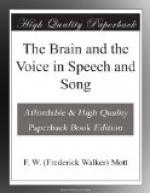Charcot in reference to the interpretation of speech defects divided persons into four classes—auditives, visuals, motors, and indifferents. There are really no separate classes, but only different kinds of word-memory in different degrees of excellence as regards the first three; and as regards the fourth there is no one kind of memory developed to a preponderating degree. Bastian doubts the second class, but does not deny that the visual type may exist; for Galton has undoubtedly shown that visual memory and power of recall of visual word images varies immensely in different individuals, and it is unquestionable that certain individuals possess the visualising faculty to an extraordinary degree; some few, moreover, can see mentally every word that is uttered; they give their attention to the visual symbolic equivalent and not to the auditory. Such persons may, as Ribot supposes, habitually think and represent objects by visual typographic images. Lord Macaulay and Sir James Paget were notable possessors of this visualising faculty. The former is said to have been able to read a column of “The Times” and repeat it verbatim; the latter could deliver his lectures verbatim as he had written them. Both saw mentally the print or MS. in front of them.
Nevertheless it is a question of degree how much motor images enter into silent thought and into the primary revival of words in different individuals. Mach in “Analysis of Sensations” says: “It is true that in my own case words (of which I think) reverberate loudly in my ear. Moreover, I have no doubt that thoughts may be directly excited by the ringing of a house-bell, by the whistle of a locomotive, etc., that small children and even dogs understand words which they cannot repeat. Nevertheless I have been convinced by Stricker that the ordinary and most familiar, though not the only possible way, by which speech is comprehended is really motor and that we should be badly off if we were without it. I can cite corroborations of this view from my own experience. I frequently see strangers who are endeavouring to follow my remarks slightly moving their lips.”
THE PRIMARY SITE OF REVIVAL OF WORDS IN SILENT THOUGHT
Since destructive lesions of the speech zone of the left hemisphere in right-handed persons leads to inability to revive the memory pictures of the sounds of words as heard in ordinary speech, the revival of visual impressions as seen in printed or written characters, and of the kinaesthetic (sense of movement) impressions concerned with the alterations of the minute tensions of the muscle structures employed in the articulation of words, it must be presumed that the left hemisphere in right-handed persons is dominant in speech and silent thought; it may even dominate the use of the left hand for many movements. But does not the right hemisphere take a part? Yes; and I will




